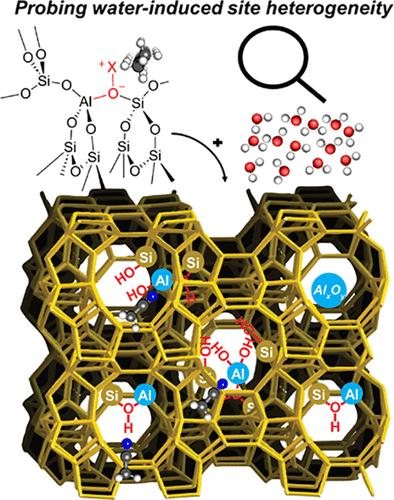Quantifying Site Heterogeneity in Microporous Aluminosilicates and Implications for Catalysis
IF 13.1
1区 化学
Q1 CHEMISTRY, PHYSICAL
引用次数: 0
Abstract
Zeolites and related microporous materials are key acid catalysts for many crucial transformations in both the gas and liquid phases for processes such as hydrocarbon refining, isomerization, and biomass upgrading. However, their catalytic behavior becomes complex under harsh hydrothermal conditions due to the formation of nonframework sites, which can significantly impact reaction rates and selectivity, complicating reproducibility and research evaluations. Therefore, in this work, we set out to establish characterization and titration protocols to identify and quantify site heterogeneity (i.e., differentiate between framework, partially hydrolyzed, and extraframework sites) of steamed microporous aluminosilicates, in contrast to solely using Brønsted and Lewis designations. For this purpose, we employ commercial MFI aluminosilicates (ZSM-5) of differing site heterogeneity and Si/Al ratios to quantify their site distribution through a combination of temperature-programmed desorption and FTIR protocols while contextualizing their effect on propane cracking rate constants. From the conclusions obtained, the present work provides a nuanced titration strategy on how to quantitatively determine the site heterogeneity of aluminosilicates and Al content without catalyst modification and with considerations for physisorbed species, base type, and size. We also reinforce literature observations of how water can induce changes in Al coordination even at ambient conditions, especially with increasing Al content, before catalysis, which adds variability in rate measurements. These observations and approaches should be extendable to other acidic zeolites and present ways to determine the site heterogeneity of materials in their dried state, in an accessible manner, that can serve as a starting point to evaluate structure–performance relationships.

微孔硅酸铝中位点非均质性的量化及其催化意义
沸石和相关的微孔材料是油气精炼、异构化和生物质升级等过程中许多重要的气液相转化的关键酸催化剂。然而,在恶劣的水热条件下,由于非框架位点的形成,它们的催化行为变得复杂,这将显著影响反应速率和选择性,使再现性和研究评价复杂化。因此,在这项工作中,我们开始建立表征和滴定方案,以确定和量化蒸微孔硅酸铝的位点异质性(即区分框架、部分水解和框架外位点),而不是单独使用Brønsted和Lewis命名。为此,我们采用了具有不同位点异质性和Si/Al比的商业MFI铝硅酸盐(ZSM-5),通过程序升温解吸和FTIR协议的组合来量化它们的位点分布,同时分析它们对丙烷裂解速率常数的影响。根据所得的结论,本工作提供了一种细致入微的滴定策略,即如何在没有催化剂改性的情况下定量确定硅酸铝的位点异质性和Al含量,并考虑到物理吸附的种类、碱类型和大小。我们还加强了文献观察,即水如何在环境条件下诱导Al配位的变化,特别是在催化前Al含量增加的情况下,这增加了速率测量的可变性。这些观察和方法应该扩展到其他酸性沸石,并以一种容易接近的方式确定材料在干燥状态下的位置非均质性,这可以作为评估结构-性能关系的起点。
本文章由计算机程序翻译,如有差异,请以英文原文为准。
求助全文
约1分钟内获得全文
求助全文
来源期刊

ACS Catalysis
CHEMISTRY, PHYSICAL-
CiteScore
20.80
自引率
6.20%
发文量
1253
审稿时长
1.5 months
期刊介绍:
ACS Catalysis is an esteemed journal that publishes original research in the fields of heterogeneous catalysis, molecular catalysis, and biocatalysis. It offers broad coverage across diverse areas such as life sciences, organometallics and synthesis, photochemistry and electrochemistry, drug discovery and synthesis, materials science, environmental protection, polymer discovery and synthesis, and energy and fuels.
The scope of the journal is to showcase innovative work in various aspects of catalysis. This includes new reactions and novel synthetic approaches utilizing known catalysts, the discovery or modification of new catalysts, elucidation of catalytic mechanisms through cutting-edge investigations, practical enhancements of existing processes, as well as conceptual advances in the field. Contributions to ACS Catalysis can encompass both experimental and theoretical research focused on catalytic molecules, macromolecules, and materials that exhibit catalytic turnover.
 求助内容:
求助内容: 应助结果提醒方式:
应助结果提醒方式:


